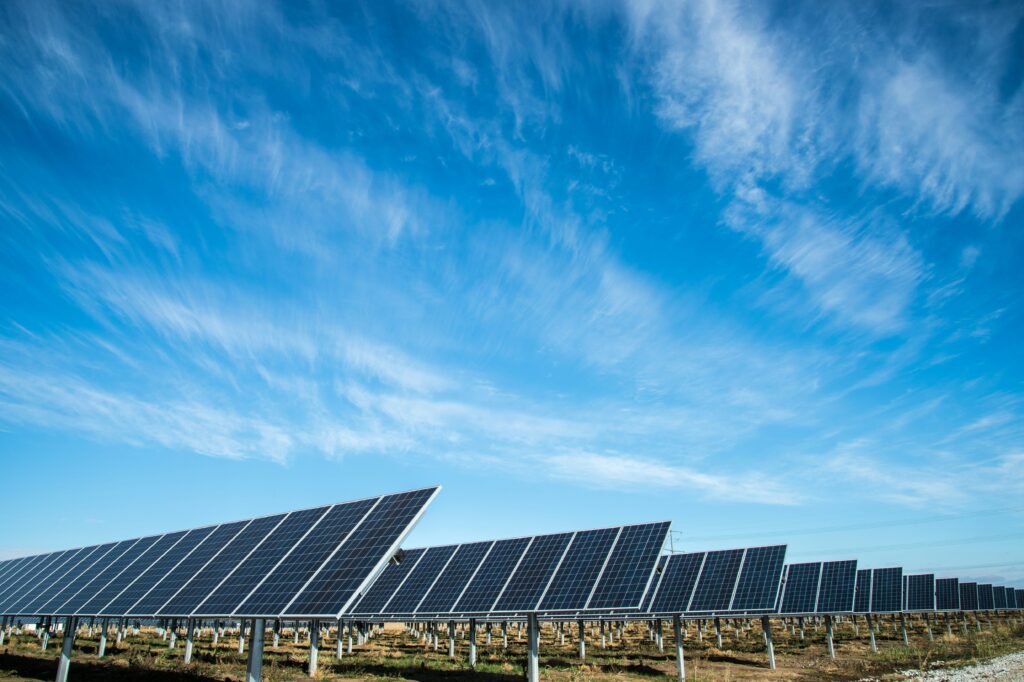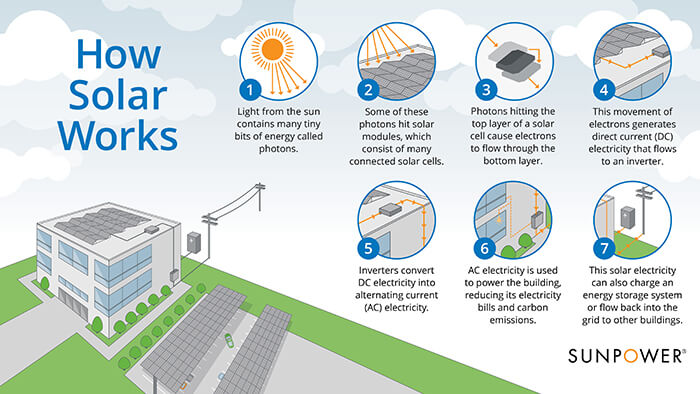Solar panels generate electricity by the photovoltaic effect, which is the conversion of sunlight into electrical energy. Solar panels are designed to capture sunlight and convert it into usable electricity.

This is accomplished through the use of photovoltaic cells, which are made up of semiconductor materials. When sunlight hits the cells, it excites the electrons within the material, causing them to flow and create a direct current (DC) electrical charge.
This DC current is then converted into alternating current (AC) electricity through an inverter, which can be used to power homes, businesses, and other electrical devices. The process is clean, renewable, and sustainable, making solar panels an excellent choice for reducing reliance on fossil fuels and combating climate change.
Solar panels generate electricity through the photovoltaic effect. This effect occurs when certain materials, typically silicon-based in solar panels, absorb photons (particles of light) from sunlight. When photons strike the surface of the solar panel, they transfer their energy to the electrons in the atoms of the semiconductor material.
As a result of this energy transfer, some of the electrons in the material gain enough energy to break free from their atoms and move freely. This creates a flow of electrons, known as an electric current. By placing metal conductors on the top and bottom of the solar cell, this flow of electrons can be captured and directed as electricity to power various devices and systems.
In essence, solar panels convert sunlight directly into electrical energy by harnessing the energy of photons and generating an electric current through the movement of electrons within the solar panel material.
History Of Solar Panels
Solar panels generate electricity through the photovoltaic effect, where sunlight is converted into electrical energy. This transformative process occurs within the cells of the solar panels, allowing them to harness the sun’s energy for power generation.
The history of solar panels dates back to the 19th century, with significant advancements occurring over the decades. Here’s a brief overview:
- Discovery of the Photovoltaic Effect (1839): The foundation of solar panel technology lies in the discovery of the photovoltaic effect by French physicist Alexandre-Edmond Becquerel. He observed that certain materials generate an electric current when exposed to light.
- Early Solar Cell Development (late 19th century to early 20th century): Scientists experimented with various materials to harness solar energy more effectively. This period saw the development of the first selenium solar cell by Charles Fritts in 1883, which had a conversion efficiency of around 1-2%.
- Improvements in Efficiency (mid-20th century): Research and development efforts continued, leading to improvements in solar cell efficiency. In the 1950s, Bell Laboratories produced the first practical silicon solar cell, achieving an efficiency of around 6%.
- Space Applications (1950s and 1960s): Solar panels gained prominence in space exploration due to their ability to generate electricity in the absence of traditional power sources. The Vanguard 1 satellite, launched in 1958, utilized a small array of solar cells.
- Growth of Solar Technology (1970s to 1990s): During this period, advancements in semiconductor technology and manufacturing processes contributed to the growth of solar panel technology. Solar cells became more efficient and affordable, leading to their use in remote locations and off-grid applications.
- Grid-Connected Solar (late 20th century to present): The late 20th century saw the emergence of grid-connected solar systems, where solar panels are connected to the electricity grid to supply power to homes and businesses. This period also witnessed government incentives and subsidies aimed at promoting solar energy adoption.
- Technological Innovations (21st century): The 21st century brought further advancements in solar panel technology, including improvements in efficiency, durability, and aesthetics. Thin-film solar panels, concentrating photovoltaics, and other innovative designs have expanded the range of solar applications.
- Rapid Growth and Cost Reductions (present): In recent years, solar energy has experienced exponential growth worldwide, driven by declining costs, environmental concerns, and energy security. Solar panels have become increasingly affordable and widely accessible, with installations ranging from residential rooftops to utility-scale solar farms.
Overall, the history of solar panels reflects a journey of scientific discovery, technological innovation, and growing recognition of the potential of solar energy as a sustainable and renewable power source.
Invention Of Solar Panels
The invention of solar panels can be traced back to the 19th century when
French physicist Alexandre Edmond Becquerel discovered the photovoltaic effect.
This phenomenon, where certain materials generate an electric current when
exposed to light, laid the foundation for the development of solar panels.
Early Developments
In the 1950s, researchers made significant strides in the field of solar
energy. Bell Laboratories introduced the first practical solar cell capable of
converting enough sunlight into electricity to power everyday electrical
equipment. This breakthrough marked the beginning of modern solar technology
and paved the way for the widespread adoption of solar panels.

Understanding Solar Energy
Solar energy, derived from the sun’s abundant and renewable radiation, stands as one of the most promising solutions to address the global energy challenge. Harnessing this energy involves sophisticated technologies and scientific principles, culminating in the conversion of sunlight into usable electricity. Understanding solar energy necessitates delving into the mechanisms behind its capture, conversion, and utilization. From the photovoltaic effect powering solar panels to the intricate grid connections enabling seamless integration, each facet of solar energy plays a vital role in shaping our sustainable energy future. In this exploration, we embark on a journey to unravel the complexities and potentials of solar energy, illuminating its significance in the quest for a cleaner and more resilient energy landscape.
How Does Solar Energy Work?
Solar energy is a renewable energy source that provides us with a clean and sustainable way to power our homes and businesses. But how exactly does solar energy work? Let’s break it down:
- Sunlight: The sun’s rays contain photons, which are tiny particles of light.
- Photovoltaic Cells: When sunlight hits a solar panel, it is absorbed by photovoltaic cells. These cells are made up of semiconductors, like silicon, that can convert sunlight into electricity.
- Electron Excitation: As the photons strike the photovoltaic cells, they excite the electrons in the cell’s atoms, causing them to break free from their atomic bonds.
- Electric Current: Once the electrons are free, they create an electric current, which can be harnessed and used to power our homes and businesses.
Solar panels are made up of several individual photovoltaic cells connected together, with each cell producing a relatively small amount of electricity. However, when these cells are combined in larger panels, they can generate enough electricity to power an entire building.
The Role Of Photovoltaic Cells
Photovoltaic cells play a crucial role in the process of converting solar energy into electricity. These cells are composed of layers of material with differing electrical charges. The most common material used in these cells is silicon due to its ability to convert light into electricity efficiently.
When sunlight strikes a photovoltaic cell, the energy is absorbed by the electrons within the cell. This absorption causes the electrons to gain energy and break free from their atom’s bonds, creating an electric current. The electric current produced by these cells is in the form of direct current (DC).
To make the electricity generated by photovoltaic cells usable for our daily energy needs, an inverter is used to convert the DC electricity into alternating current (AC) electricity. AC electricity is what we use in our homes to power appliances, lights, and other electrical devices.
By harnessing the power of photovoltaic cells and the conversion of sunlight into electricity, solar panels provide an environmentally friendly alternative to traditional energy sources. Not only do they reduce greenhouse gas emissions and dependence on fossil fuels, but they also help to decrease electricity costs in the long run.
The Science Behind Solar Panels
Solar panels have quickly become popular sources of renewable energy, providing electricity to millions of homes and businesses worldwide. But have you ever wondered how these panels are able to generate electricity? In this article, we’ll delve into the science behind solar panels and explore the fascinating process that allows them to convert sunlight into usable power.
In an era marked by environmental concerns and the pursuit of sustainable energy sources, solar panels stand out as a beacon of hope for a cleaner, more efficient future. Harnessing the boundless energy of the sun, these marvels of modern technology have revolutionized the way we generate electricity.
The science behind solar panels is as fascinating as it is ingenious. At its core lies the principle of photovoltaic effect, a phenomenon that enables the conversion of sunlight into electricity. This process involves intricate interactions between photons, the fundamental particles of light, and semiconductor materials within the solar panels.
Beyond their technical intricacies, solar panels symbolize a shift towards renewable energy, offering a pathway to reduce dependence on fossil fuels and mitigate the impacts of climate change. Understanding the science behind these remarkable devices is not only crucial for advancing solar technology but also for shaping a sustainable future for generations to come.
In this exploration, we delve into the science that powers solar panels, unraveling the mysteries behind their operation and examining their transformative potential in reshaping the global energy landscape.
The Photovoltaic Effect
The photovoltaic effect is the basis for solar panel operation. This effect occurs when photons, which are particles of light, strike the surface of a solar cell. Within the cell, a semiconductor material, usually made of silicon, absorbs the photons. The absorption of photons causes electrons in the semiconductor atoms to become excited and escape from their bound states.
Conversion Of Sunlight To Electricity
Once the electrons are released, an electric field created within the semiconductor pushes them towards a collection electrode. This creates a flow of electrons, known as an electric current. By strategically placing metal contacts on the top and bottom of the solar cell, this current can be captured and sent through an external circuit.
Solar cells are typically interconnected to form solar panels, increasing the overall energy output. When sunlight hits the panel, it passes through a transparent protective coating and then reaches the interconnected cells. Each cell absorbs the sunlight and converts it into electricity using the photovoltaic effect. The combined output of all the cells within the panel is harnessed to power various devices, homes, or even entire communities.
Conclusion
Solar panels are truly an ingenious invention that relies on the science behind the photovoltaic effect to generate electricity. By understanding this process, we gain a deeper appreciation for the power of solar energy and its immense potential to shape a more sustainable future.
Key Components Of Solar Panels
Solar panels, the cornerstone of solar energy systems, are marvels of engineering that capture sunlight and convert it into usable electricity. Comprising a multitude of intricate components, each playing a crucial role in the process, these panels exemplify the synergy between cutting-edge technology and sustainable energy solutions.
The key components of solar panels is essential to grasp their functionality and appreciate their significance in the realm of renewable energy. From photovoltaic cells to inverters and beyond, each element contributes to the efficiency and reliability of these energy-generating modules.
Factors Affecting Solar Panel Efficiency
Solar panel efficiency is impacted by several factors, such as sunlight intensity, temperature, and shading. These factors can influence the amount of electricity generated by solar panels. By understanding these variables, we can maximize the efficiency of solar panels and improve their overall performance.
Factors Affecting Solar Panel Efficiency:
Solar panels are a popular and environmentally friendly way to generate electricity. Understanding the factors that affect their efficiency is crucial in maximizing their potential. Several key aspects play a role in determining just how effectively solar panels can harness the sun’s energy to generate electricity. From sunlight intensity and angle to temperature and shading, let’s explore these factors in detail.
Sunlight Intensity And Angle:
The intensity and angle of sunlight are crucial factors that influence solar panel efficiency. When the sun’s rays hit the solar panels directly, they generate the maximum amount of energy. However, if the sunlight is obstructed or the panels are not angled correctly, their efficiency can be significantly reduced.
Ordered List:
- Placement: Ensuring solar panels are placed in an area where they receive direct sunlight for the majority of the day is crucial.
- Orientation: Positioning solar panels at the optimal angle to catch the maximum amount of sunlight can greatly enhance their efficiency.
Temperature:
Temperature plays a significant role in solar panel efficiency. While it may seem counterintuitive, high temperatures can actually reduce the efficiency of solar panels. As the temperature rises, the performance of the panels tends to decrease due to a decrease in their ability to convert sunlight into electricity.
Unordered List:
- Heat Dissipation: Proper ventilation and cooling methods can help dissipate excess heat, maintaining optimal performance.
- Temperature Coefficient: Understanding the temperature coefficient of solar panels can help gauge their performance in different temperature ranges.
Shading And Obstructions:
Shading and obstructions can significantly impact solar panel efficiency. When even a small part of a solar panel is shaded, whether by nearby trees, buildings, or any other obstructions, it can diminish the overall output of the entire panel system.
Table:
| Factors | Impact |
|---|---|
| Shading | Considerable decrease in energy production |
| Dirt and Dust | Reduction in efficiency due to obstruction of sunlight |
| Cloud Cover | Reduction in sunlight intensity, hence decreased efficiency |
Understanding these factors that affect solar panel efficiency is essential in optimizing their performance. By ensuring proper placement and orientation, managing temperature, and mitigating shading and obstructions, you can get the most out of your solar panels and generate electricity efficiently.

Benefits Of Solar Power
Solar panels generate electricity by converting sunlight into energy through photovoltaic cells. This sustainable energy source reduces carbon emissions, lowers energy costs, and provides a reliable power supply. The benefits of solar power include environmental conservation and financial savings, making it a promising alternative to traditional energy sources.
Renewable and Clean Energy Source: Solar power is a renewable energy source that utilizes the unlimited energy from the sun. Unlike fossil fuels, which are finite and contribute to harmful carbon emissions, solar power is clean and does not harm the environment. By harnessing the power of sunlight, solar panels produce electricity without producing any greenhouse gas emissions, making it a sustainable and eco-friendly option.
Reduced Electricity Costs: One of the most significant benefits of solar power is the potential for reduced electricity costs. By installing solar panels, homeowners and businesses can generate their electricity and decrease their reliance on the grid. Since sunlight is free, once the initial investment in solar panels is recovered, the electricity generated becomes essentially free. This can lead to significant savings on monthly electricity bills, allowing individuals and organizations to allocate their financial resources elsewhere.
Challenges And Future Developments
As solar panel technology continues to advance, it faces certain challenges and holds promising future developments. Overcoming these challenges is crucial for the widespread adoption of solar energy. Let’s explore the key aspects of these challenges and future developments.
Costs And Initial Investment
Solar panels have traditionally required a substantial initial investment, which has been a deterrent for many considering solar energy adoption. However, the decreasing costs of solar panel installations and the availability of financing options are making solar energy more affordable for homeowners and businesses. Additionally, government incentives and tax credits are further reducing the initial investment, making solar energy an attractive option for many.
Advancements In Solar Technology
The continual advancements in solar technology are driving down costs and increasing efficiency. Innovations like higher conversion efficiencies of solar cells, improved energy storage solutions, and the development of new materials for solar panels are significantly enhancing the performance of solar energy systems. With these advancements, the future of solar energy looks promising, offering a more sustainable and cost-effective energy source.

Credit: sunpower.maxeon.com
Frequently Asked Questions Of Why Do Solar Panels Generate Electricity
Why Do Solar Panels Generate Electricity?
Solar panels generate electricity by converting sunlight into usable energy through the photovoltaic effect.
How Do Solar Panels Convert Sunlight Into Electricity?
Solar panels convert sunlight into electricity through the interaction between photons and semiconductors within the panel, creating a flow of electrons.
What Are The Benefits Of Solar Panels Generating Electricity?
Solar panels generating electricity offer numerous benefits, including reduced carbon footprint, energy cost savings, and increased energy independence.
Conclusion
Understanding the process of solar panel electricity generation is essential for embracing sustainable energy solutions. Solar panels work by harnessing the power of the sun to create clean and renewable electricity. By converting sunlight into usable energy, solar panels play a crucial role in reducing carbon emissions and mitigating the impact of climate change.
Embracing solar technology is a significant step towards a more sustainable and eco-friendly future.